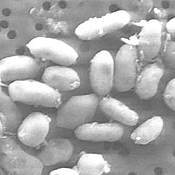

Follow-up research on GFAJ-1, a Halomonas bacterium cultured from Mono Lake’s shallow marine sediments, is back in the news after two new, independent studies concluded that this strange bacterium does not incorporate arsenic into its biomolecular make-up. This new research runs counter to the claims of an original study by Dr. Felisa Wolfe-Simon that concluded that GFAJ-1 took up arsenic into its DNA, suggesting that the foundation of biochemistry was perhaps more flexible than was previously known.
In December 2010 Dr. Wolfe-Simon broke the news about the microbe’s ability to incorporate arsenic during a NASA news conference. In the wake of the announcement there was considerable controversy and backlash within the scientific community (almost entirely online), well in advance of any further peer-reviewed research. Even with these recent contrary findings there is one thing that all the research does point to: Mono Lake’s GFAJ-1 is weird. It survives astounding concentrations of arsenic (in a laboratory environment) and how it accomplishes this is not clear. Go here and here to reference the latest research abstracts.

Is there any danger from the Mono Lake Water involved?
No danger since we don’t drink Mono Lake water! The only real danger is inhaling it from the dust that blows off the exposed lakebed during dust storms. Raising Mono Lake to an average level of 6392 feet above sea level is expected to solve that problem.